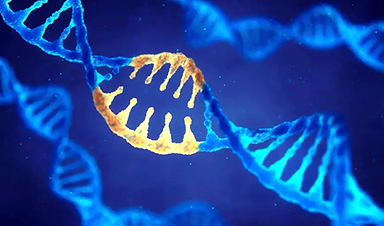Microorganisms leverage the CRISPR-Cas system as a defense mechanism against viral intrusions. In the realm of genetic engineering, this microbial immune system is repurposed for the targeted modification of the genetic makeup.
Under the leadership of Professor Dr. Alexander Probst, microbiologist at the Research Center One Health Ruhr at the Research Alliance Ruhr a research team has now discovered another function of this specialised genomic sequence: archaea – microorganisms that are often very similar to bacteria in appearance – also use them to fight parasites.
The team has recently published their findings in Nature Microbiology.

Dr. Alexander Probst. Credit: UDE/Bettina Engel-Albustin
Biochemists Emmanuelle Charpentier and Jennifer Doudna received the Nobel Prize for the biotechnological application of the CRISPR-Cas systems, or ‘genetic scissors’, for genetic engineering in 2020. However, many functions of this genetic tool are still unexplored to date. Could microorganisms, for example, use them to fight off other microorganisms that live on them as parasites?
With this research question in mind, Alexander Probst analyzed the genetic material of microbes in the Earth’s deep crust. ‘More than 70 percent of the Earth’s microorganisms are housed in the deep biosphere. If we want to understand diversity on our planet, it is worth taking a look into the deep’, he explains.
With his team, the microbiologist has analyzed the water that a geyser in the USA spits to the surface from the depths, as well as samples from the Horonobe underground laboratory in Japan. The research team focused on archaea, which live in the ecosystem as hosts and parasites. The tiny microbes are highly similar to bacteria in cell size but have substantially different physiological properties.
The result of their genomic analysis provided new insights: there were conspicuously few parasites in the vicinity of the hosts, and the hosts showed genetic resistance to the parasites. The researchers discovered the reason for this in the genetic scissors in the genome of the microorganisms. ‘In the course of evolution, the archaea have incorporated the parasitic DNA. If a parasite with the same DNA now attacks the organism, the foreign genetic material is probably recognized by the CRISPR system and presumably decomposed’, Probst explains. The microbiologist is an expert in the analysis of genetic material from environmental samples and uses the latest methods in his lab, such as Oxford Nanopore technology, which enables rapid and comprehensive sequencing of the material.
In order to rule out the possibility that they have only come across isolated cases, the researchers have extended the analysis to over 7,000 genomes and observed the phenomenon very frequently. In future research, this finding will also facilitate distinguishing between beneficial symbionts and harmful parasites. If there has been a CRISPR recognition, the microorganism is very likely to be a parasite. This will probably also help better understand important metabolic processes, such as the carbon flow in ecosystems, in the future.
Reference: “A predicted CRISPR-mediated symbiosis between uncultivated archaea” by Sarah P. Esser, Janina Rahlff, Weishu Zhao, Michael Predl, Julia Plewka, Katharina Sures, Franziska Wimmer, Janey Lee, Panagiotis S. Adam, Julia McGonigle, Victoria Turzynski, Indra Banas, Katrin Schwank, Mart Krupovic, Till L. V. Bornemann, Perla Abigail Figueroa-Gonzalez, Jessica Jarett, Thomas Rattei, Yuki Amano, Ian K. Blaby, Jan-Fang Cheng, William J. Brazelton, Chase L. Beisel, Tanja Woyke, Ying Zhang and Alexander J. Probst, 27 July 2023, Nature Microbiology.
DOI: 10.1038/s41564-023-01439-2
News
Team finds flawed data in recent study relevant to coronavirus antiviral development
The COVID pandemic illustrated how urgently we need antiviral medications capable of treating coronavirus infections. To aid this effort, researchers quickly homed in on part of SARS-CoV-2's molecular structure known as the NiRAN domain—an [...]
Drug-Coated Neural Implants Reduce Immune Rejection
Summary: A new study shows that coating neural prosthetic implants with the anti-inflammatory drug dexamethasone helps reduce the body’s immune response and scar tissue formation. This strategy enhances the long-term performance and stability of electrodes [...]
Scientists discover cancer-fighting bacteria that ‘soak up’ forever chemicals in the body
A family of healthy bacteria may help 'soak up' toxic forever chemicals in the body, warding off their cancerous effects. Forever chemicals, also known as PFAS (per- and polyfluoroalkyl substances), are toxic chemicals that [...]
Johns Hopkins Researchers Uncover a New Way To Kill Cancer Cells
A new study reveals that blocking ribosomal RNA production rewires cancer cell behavior and could help treat genetically unstable tumors. Researchers at the Johns Hopkins Kimmel Cancer Center and the Department of Radiation Oncology and Molecular [...]
AI matches doctors in mapping lung tumors for radiation therapy
In radiation therapy, precision can save lives. Oncologists must carefully map the size and location of a tumor before delivering high-dose radiation to destroy cancer cells while sparing healthy tissue. But this process, called [...]
Scientists Finally “See” Key Protein That Controls Inflammation
Researchers used advanced microscopy to uncover important protein structures. For the first time, two important protein structures in the human body are being visualized, thanks in part to cutting-edge technology at the University of [...]
AI tool detects 9 types of dementia from a single brain scan
Mayo Clinic researchers have developed a new artificial intelligence (AI) tool that helps clinicians identify brain activity patterns linked to nine types of dementia, including Alzheimer's disease, using a single, widely available scan—a transformative [...]
Is plastic packaging putting more than just food on your plate?
New research reveals that common food packaging and utensils can shed microscopic plastics into our food, prompting urgent calls for stricter testing and updated regulations to protect public health. Beyond microplastics: The analysis intentionally [...]
Aging Spreads Through the Bloodstream
Summary: New research reveals that aging isn’t just a local cellular process—it can spread throughout the body via the bloodstream. A redox-sensitive protein called ReHMGB1, secreted by senescent cells, was found to trigger aging features [...]
AI and nanomedicine find rare biomarkers for prostrate cancer and atherosclerosis
Imagine a stadium packed with 75,000 fans, all wearing green and white jerseys—except one person in a solid green shirt. Finding that person would be tough. That's how hard it is for scientists to [...]
Are Pesticides Breeding the Next Pandemic? Experts Warn of Fungal Superbugs
Fungicides used in agriculture have been linked to an increase in resistance to antifungal drugs in both humans and animals. Fungal infections are on the rise, and two UC Davis infectious disease experts, Dr. George Thompson [...]
Scientists Crack the 500-Million-Year-Old Code That Controls Your Immune System
A collaborative team from Penn Medicine and Penn Engineering has uncovered the mathematical principles behind a 500-million-year-old protein network that determines whether foreign materials are recognized as friend or foe. How does your body [...]
Team discovers how tiny parts of cells stay organized, new insights for blocking cancer growth
A team of international researchers led by scientists at City of Hope provides the most thorough account yet of an elusive target for cancer treatment. Published in Science Advances, the study suggests a complex signaling [...]
Nanomaterials in Ophthalmology: A Review
Eye diseases are becoming more common. In 2020, over 250 million people had mild vision problems, and 295 million experienced moderate to severe ocular conditions. In response, researchers are turning to nanotechnology and nanomaterials—tools that are transforming [...]
Natural Plant Extract Removes up to 90% of Microplastics From Water
Researchers found that natural polymers derived from okra and fenugreek are highly effective at removing microplastics from water. The same sticky substances that make okra slimy and give fenugreek its gel-like texture could help [...]
Instant coffee may damage your eyes, genetic study finds
A new genetic study shows that just one extra cup of instant coffee a day could significantly increase your risk of developing dry AMD, shedding fresh light on how our daily beverage choices may [...]





















